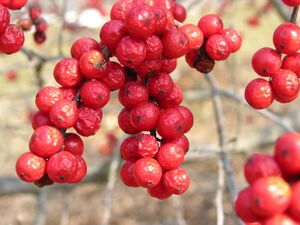Difference between revisions of "American Winterberry"
| Line 1: | Line 1: | ||
| + | {{SPlantbox | ||
| + | |Temp Metric=°F | ||
| + | |jumpin=If this plant info box on watering; zones; height; etc. is mostly empty you can click on the edit tab and fill in the blanks! | ||
| + | |image=Upload.png | ||
| + | |image_width=240 | ||
| + | }} | ||
| + | {{Inc| | ||
| + | Ilex verticillata, Gray (Prinos verticillatus, Linn.). Black Alder. Winterberry. Fig. 1950. Shrub, with spreading branches: lvs. obovate to oblanceolate or lanceolate, acuminate or acute, serrate or doubly serrate, usually pubescent beneath, 1 ½ -3 in. long, turning black after frost: all fls. short-stalked: fr. bright red, about ¼ in. across. June, July: fr. in Oct. Canada to Fla., west to Wis. and Mo. Em. 388. F.E. 24: 779. Ilex verticillata var. tenuifolia, Torr. (I. bronxensis, Brit.). Lvs. obovate, glabrous or pubescent, thin: fls. and frs. larger. B.B. (ed. 2) 3:489. Ilex verticillata var. chrysocarpa, Rob. Fra. bright yellow. Also I. fastigiata, Bicknell, from Nantucket, differing in its fastigiate habit and in the narrower lanceolate or oblong-lanceolate lvs., is probably only a variety of this species.—Very variable in shape and texture of Iva. One of the best hardy shrubs with ornamental frs. remaining on the branches until midwinter, and are rarely eaten by birds. | ||
| + | |||
| + | }} | ||
| + | |||
{{Taxobox | {{Taxobox | ||
| color = lightgreen | | color = lightgreen | ||
Revision as of 06:48, 15 March 2010
If this plant info box on watering; zones; height; etc. is mostly empty you can click on the edit tab and fill in the blanks!
Read about American Winterberry in the Standard Cyclopedia of Horticulture
|
|---|
|
Ilex verticillata, Gray (Prinos verticillatus, Linn.). Black Alder. Winterberry. Fig. 1950. Shrub, with spreading branches: lvs. obovate to oblanceolate or lanceolate, acuminate or acute, serrate or doubly serrate, usually pubescent beneath, 1 ½ -3 in. long, turning black after frost: all fls. short-stalked: fr. bright red, about ¼ in. across. June, July: fr. in Oct. Canada to Fla., west to Wis. and Mo. Em. 388. F.E. 24: 779. Ilex verticillata var. tenuifolia, Torr. (I. bronxensis, Brit.). Lvs. obovate, glabrous or pubescent, thin: fls. and frs. larger. B.B. (ed. 2) 3:489. Ilex verticillata var. chrysocarpa, Rob. Fra. bright yellow. Also I. fastigiata, Bicknell, from Nantucket, differing in its fastigiate habit and in the narrower lanceolate or oblong-lanceolate lvs., is probably only a variety of this species.—Very variable in shape and texture of Iva. One of the best hardy shrubs with ornamental frs. remaining on the branches until midwinter, and are rarely eaten by birds.
The above text is from the Standard Cyclopedia of Horticulture. It may be out of date, but still contains valuable and interesting information which can be incorporated into the remainder of the article. Click on "Collapse" in the header to hide this text. |
| American Winterberry | ||||||||||||||
|---|---|---|---|---|---|---|---|---|---|---|---|---|---|---|
 | ||||||||||||||
| Plant Info | ||||||||||||||
|
| ||||||||||||||
| Scientific classification | ||||||||||||||
| ||||||||||||||
| Binomial name | ||||||||||||||
| Ilex verticillata | ||||||||||||||
American Winterberry (Ilex verticillata), also known as Black Alder, Black Alder Winterberry, Brook Alder, Coralberry, Deciduous Holly, Deciduous Winterberry, False alder, Fever bush, Inkberry, Michigan Holly, Possumhaw, Striped Alder, Swamp Holly, Virginian Winterberry, White Alder, or Winterberry Holly, is a species of holly native to a very large area in the eastern United States and southeast Canada, particularly in wetlands. The winterberry is one of a number of hollies which are deciduous, losing their leaves in the fall. Like most hollies, it is dioecious, with separate male and female plants; the proximity of at least one male plant is required to pollenize the females in order to bear fruit.
The plant can show a lot of variation, ranging in size from 1-5 m tall. It also shows variation in width; in wet sites, it will spread to form a dense thicket, while in dry soil it remains a tight shrub. The winterberry possesses the glossy green foliage typical of hollies, and small white flowers which give rise to the numerous small red berries which give the plant its name.
The winterberry is prized for the midwinter splash of bright color from densely packed berries, whose visibility is heightened by the loss of foliage; therefore it is popular even where other, evergreen, hollies are also grown. The bare branches covered in berries are also popular for cutting and use in floral arrangements. It is a tough plant which is easy to grow, with very few diseases or pests. Although wet acidic soils are optimal, the winterberry will grow well in the average garden. Numerous cultivars are available, differing in size and shape of the plant and color of the berry. As described above, at least one male plant must be planted in proximity to one or more females for them to bear fruit.
The winterberry is also popular because its berries attract numerous species of birds; however this can also be a drawback as they also attract deer and small mammals. The berries were used by Native Americans for medicinal purposes, the origin of the name "fever bush".

